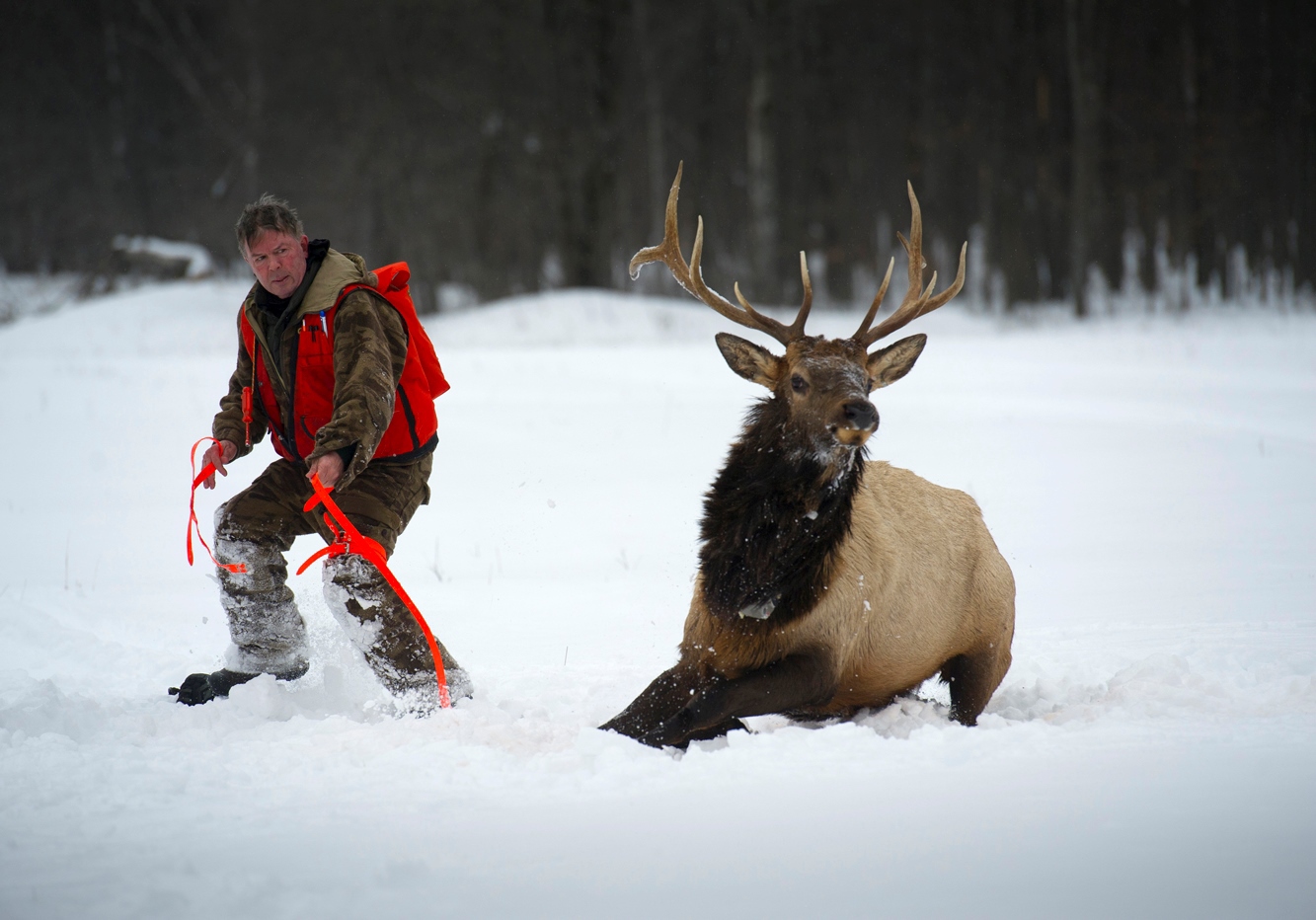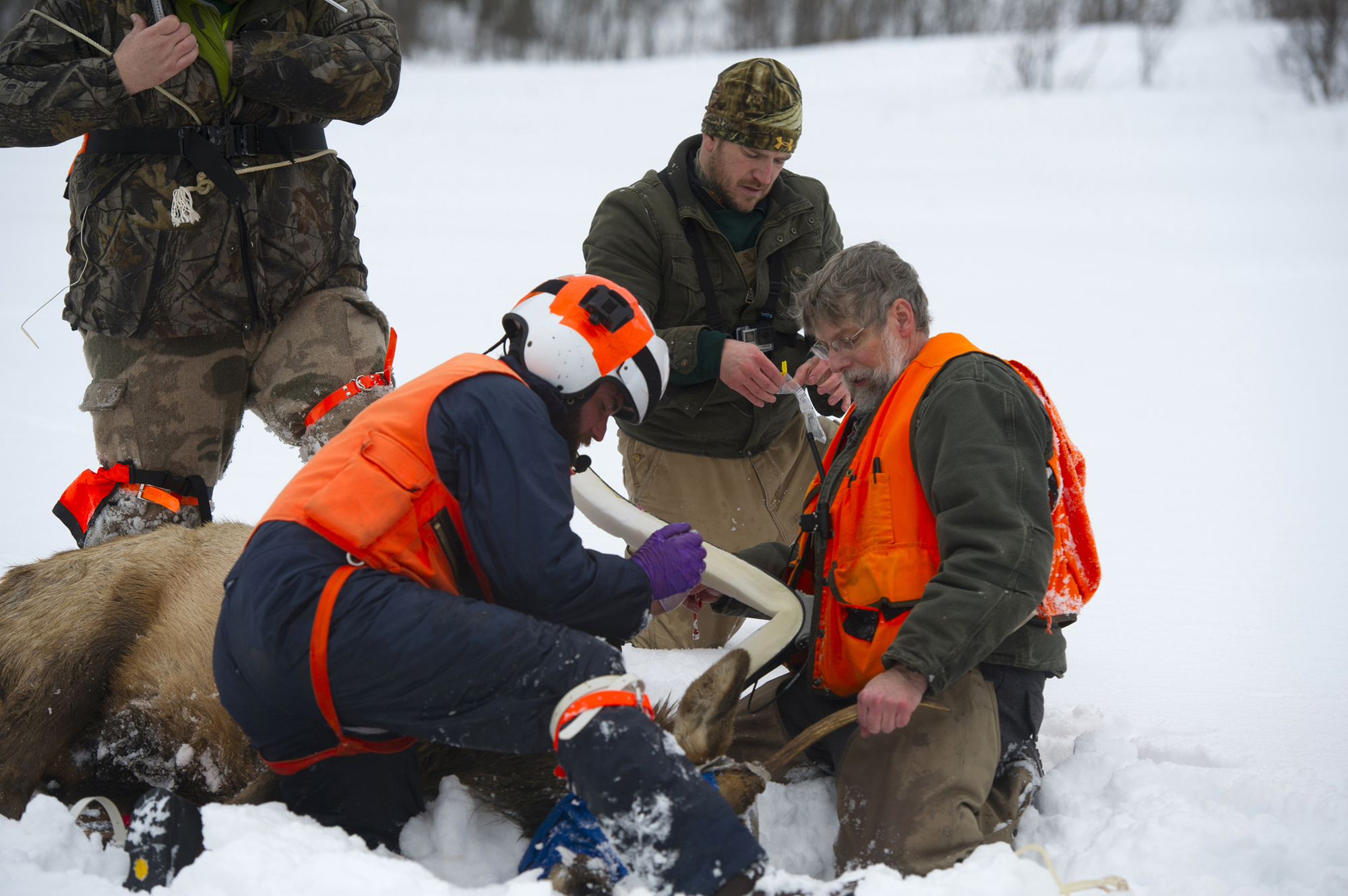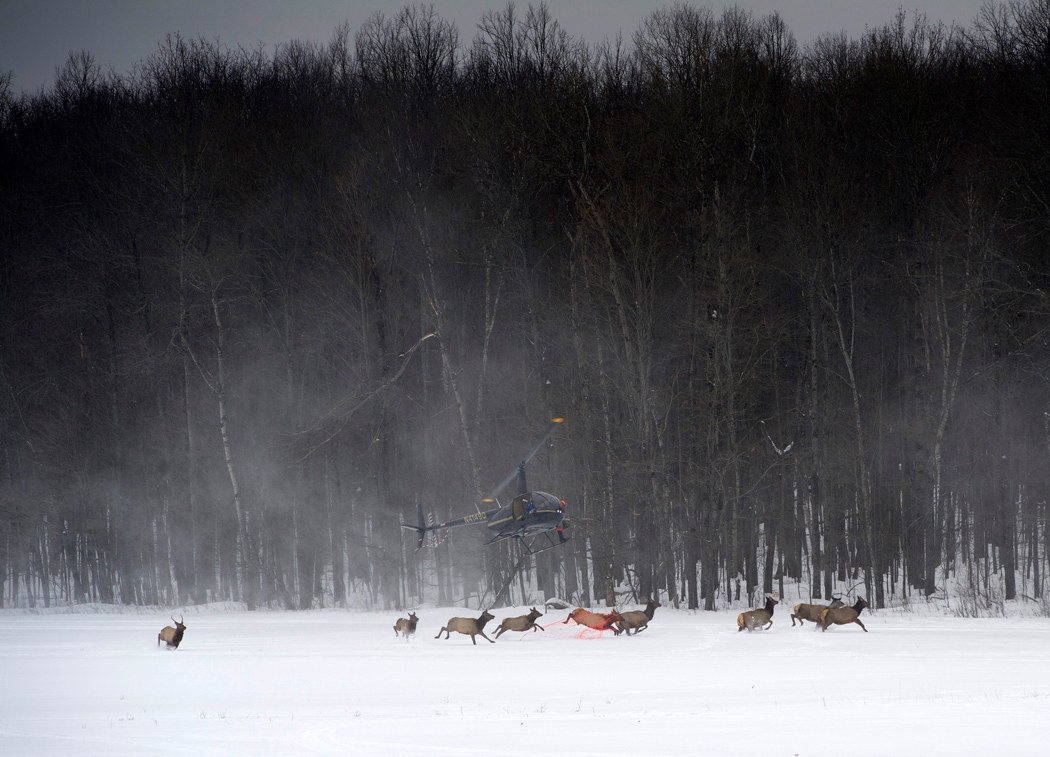|
CORRECTION: The Showcasing story issued March 10 incorrectly stated that the Michigan elk herd is the largest herd east of the Mississippi, which is not accurate. The story (below) has been edited to remove that detail. Please use this corrected version instead of the original. We apologize for any inconvenience.
DNR begins new elk tracking research project in the northern Lower Peninsula
An elk lies in the snow, covered by a net that just fell from the sky.
A “mugger” jumps out of a helicopter, while a ground team moves in.
This is net-gunning – a process the Michigan Department of Natural Resources used recently in the northern Lower Peninsula to fit 40 elk with GPS collars.
The DNR and Michigan State University are jointly funding this new tracking project, which is being researched by an MSU graduate student.
 Across the country, wildlife research biologists are interested in the combination of wild animals and human activities. Across the country, wildlife research biologists are interested in the combination of wild animals and human activities.
“One of the goals of this project is to look specifically at the effects of recreation in the core elk range by tracking elk movements over the next three years,” said Brian Mastenbrook, DNR wildlife field operations manager.
Michigan’s core elk range includes the Pigeon River Country State Forest, which encompasses more than 100,000 acres of public land northeast of Gaylord in Otsego and Cheboygan counties.
This tracking research project had been in the works since 2006 and was identified by the DNR’s Elk Management Advisory Team as a subject to be analyzed.
“In the early 1980s, our research looked at the effects of oil and gas development. In the late 1980s, we looked at how hunting affected elk behavior within the elk range,” said DNR wildlife research biologist Dean Beyer. “Now as time has passed, we face new issues. This research is designed to look at elk habitat and how elk move in relation to human activities, specifically horseback and mountain bike riding.”
The net-gunning capture effort began Feb. 14 with a safety meeting of DNR staff, Michigan State University researchers and a helicopter flight crew from Texas. In all, about two dozen people were involved with the process.
With multiple aircraft, ground crews and live animals involved, clear and reliable communication was needed. Also, the elk would not be tranquilized, making this collaring effort unique.
 “Not tranquilizing an animal changes the ground game in this collaring. We are handling large animals, fully aware and capable of moving, so we need to move quickly,” Beyer said. “The elk can then be back on their way and return to their natural setting. Fortunately, we have highly qualified and experienced staff to make this happen.” “Not tranquilizing an animal changes the ground game in this collaring. We are handling large animals, fully aware and capable of moving, so we need to move quickly,” Beyer said. “The elk can then be back on their way and return to their natural setting. Fortunately, we have highly qualified and experienced staff to make this happen.”
An adult Michigan elk can stand up to 5 feet tall at its shoulder and weigh up to 900 pounds. The male, or bull, elk hadn’t dropped their antlers at the time of collaring, adding sharp-polished bone, weighing up to 40 pounds, into the safety equation.
Crews in two DNR airplanes, looking down from low altitude, had no problem locating groups of the large elk against the white, snowy backdrop.
“It’s like hunting for morel mushrooms,” said DNR wildlife technician Mark Monroe. “Just like morels, if one elk is spotted, typically others can be found – because elk are a social animal.”
Monroe was leading the ground team of multiple snowmobiles that were in constant radio communication with the two airplanes and the helicopter.
“The plane would alert us to the number of elk they’d spotted, their location and if they were males or females,” Monroe said. “The best reports were multiple elk near a clearing – which is great, because we need the room to work.”
The helicopter crew and the ground team would develop their plan – the route, number of elk and which team would go where.
Ground teams would then head in on snowmobiles.
Timing was important. They couldn’t go in before the elk were netted or they would risk scaring away the big animals.
Guided by crew in the tw o DNR airplanes, the helicopter would fly low to herd the elk into a safe position for capture. o DNR airplanes, the helicopter would fly low to herd the elk into a safe position for capture.
The net-gun was then fired from the helicopter to capture the elk.
The “mugger” is the first person to get out of the helicopter once the elk is netted. Muggers hold the net until others arrive.
Experienced handlers immediately place a blindfold on the captured elk and secure the legs with hobbles, which are small belt-like straps.
Meanwhile, other members of the team start to remove the tangled bright orange net from the captured elk.
Now, the crew will fit the elk with a GPS tracking collar. The collar sends signals to satellites, providing researchers with information about the elk’s movements and location at any given time.
The collar is designed to fall off after three years, eliminating the need for researchers to handle the elk again. If elk movement isn’t observed, a distress signal will be sent.
The entire collaring process can take a three-person ground team about 10 to 15 minutes.
When the team's work is complete, the elk is released by first removing the hobbles and then the blindfold, allowing the elk to immediately run off on its own.
During this February outing, the collaring team worked out of the DNR’s Atlanta field office. The team met its goal in just two days – 20 male and 20 female elk fitted with GPS tracking collars.
“We are very excited about how quickly we were able to complete this collaring mission,” Mastenbrook said. “Although the project development itself was years in the making.”
Recently, elk population estimates were made during an airplane survey.
 DNR staff flew over the Michigan elk core area for nine days and observed 1,002 elk situated within 88 transects they flew. This aerial survey not only provided population estimates, but also showed the location of elk and the proportion of males to females. DNR staff flew over the Michigan elk core area for nine days and observed 1,002 elk situated within 88 transects they flew. This aerial survey not only provided population estimates, but also showed the location of elk and the proportion of males to females.
“As responsible managers of natural resources, we need to understand what, if any, effects recreation has on our elk,” Mastenbrook said. “We are managing wildlife for all of the people of the state of Michigan. This type of research gives us information that helps us make the right management decisions.”
Check out a video of the elk capture efforts in northern Michigan.
To learn more about Michigan’s elk populations visit www.michigan.gov/elk.
Be sure to subscribe to receive DNR email and like the DNR Facebook page to hear more about this and other exciting research projects.
Catch upcoming stories by subscribing to free, weekly “Showcasing the DNR” articles. Previous articles are available at www.michigan.gov/dnr-stories.
/Note to editors: Contact: Katie Keen, 231-775-9727, ext. 6032 or John Pepin, 906-226-1352. Accompanying photos and video are available for media download. Suggested photo captions follow. Video clips also are available for media download. Credit: Michigan Department of Natural Resources.
Capture (DSK534067): Michigan Department of Natural Resources staff work to fit a GPS collar on a captured elk. The effort is part of a new elk tracking project.
Chopper (DSK534085): A helicopter moves in on elk in the Lower Peninsula.
Release (DSK534051): Brad Johnson, a Michigan Department of Natural Resources wildlife technician, releases a GPS-collared bull elk that will be tracked in northeast Michigan.
Snowmobiles (DSK534059): Researchers work with a captured elk during a recent effort to fit 40 elk with GPS collars for tracking.
Additional photos: Pictures of Dean Beyer and Mark Monroe./
The Michigan Department of Natural Resources is committed to the conservation, protection, management, use and enjoyment of the state’s natural and cultural resources for current and future generations. For more information, go to www.michigan.gov/dnr.
|

 Across the country, wildlife research biologists are interested in the combination of wild animals and human activities.
Across the country, wildlife research biologists are interested in the combination of wild animals and human activities. “Not tranquilizing an animal changes the ground game in this collaring. We are handling large animals, fully aware and capable of moving, so we need to move quickly,” Beyer said. “The elk can then be back on their way and return to their natural setting. Fortunately, we have highly qualified and experienced staff to make this happen.”
“Not tranquilizing an animal changes the ground game in this collaring. We are handling large animals, fully aware and capable of moving, so we need to move quickly,” Beyer said. “The elk can then be back on their way and return to their natural setting. Fortunately, we have highly qualified and experienced staff to make this happen.” o DNR airplanes, the helicopter would fly low to herd the elk into a safe position for capture.
o DNR airplanes, the helicopter would fly low to herd the elk into a safe position for capture.





